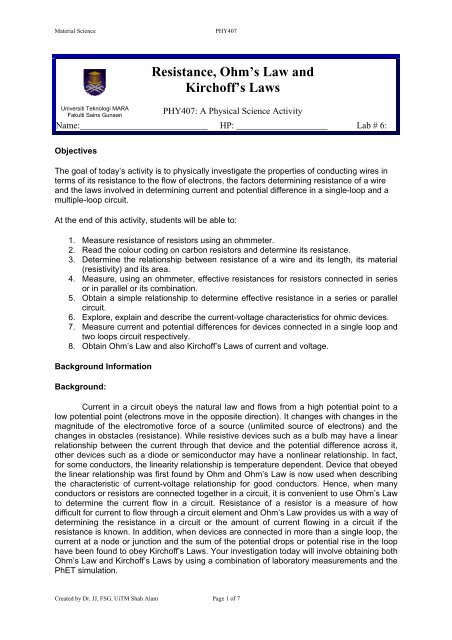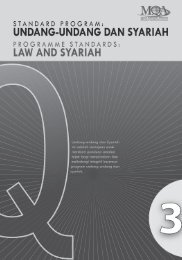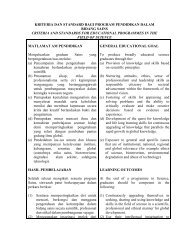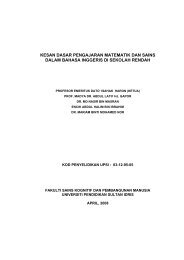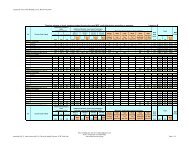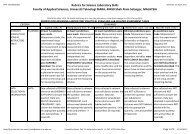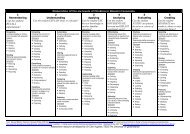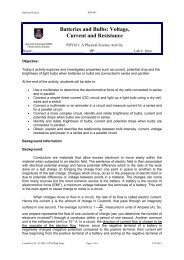Resistance, Ohm's Law and Kirchoff's Laws - DrJJ - UiTM
Resistance, Ohm's Law and Kirchoff's Laws - DrJJ - UiTM
Resistance, Ohm's Law and Kirchoff's Laws - DrJJ - UiTM
Create successful ePaper yourself
Turn your PDF publications into a flip-book with our unique Google optimized e-Paper software.
Material Science<br />
PHY407<br />
Universiti Teknologi MA RA<br />
Fakulti Sains Gunaan<br />
<strong>Resistance</strong>, Ohm’s <strong>Law</strong> <strong>and</strong><br />
Kirchoff’s <strong>Law</strong>s<br />
PHY407: A Physical Science Activity<br />
Name:____________________________ HP: ____________________ Lab # 6:<br />
Objectives<br />
The goal of today’s activity is to physically investigate the properties of conducting wires in<br />
terms of its resistance to the flow of electrons, the factors determining resistance of a wire<br />
<strong>and</strong> the laws involved in determining current <strong>and</strong> potential difference in a single-loop <strong>and</strong> a<br />
multiple-loop circuit.<br />
At the end of this activity, students will be able to:<br />
1. Measure resistance of resistors using an ohmmeter.<br />
2. Read the colour coding on carbon resistors <strong>and</strong> determine its resistance.<br />
3. Determine the relationship between resistance of a wire <strong>and</strong> its length, its material<br />
(resistivity) <strong>and</strong> its area.<br />
4. Measure, using an ohmmeter, effective resistances for resistors connected in series<br />
or in parallel or its combination.<br />
5. Obtain a simple relationship to determine effective resistance in a series or parallel<br />
circuit.<br />
6. Explore, explain <strong>and</strong> describe the current-voltage characteristics for ohmic devices.<br />
7. Measure current <strong>and</strong> potential differences for devices connected in a single loop <strong>and</strong><br />
two loops circuit respectively.<br />
8. Obtain Ohm’s <strong>Law</strong> <strong>and</strong> also Kirchoff’s <strong>Law</strong>s of current <strong>and</strong> voltage.<br />
Background Information<br />
Background:<br />
Current in a circuit obeys the natural law <strong>and</strong> flows from a high potential point to a<br />
low potential point (electrons move in the opposite direction). It changes with changes in the<br />
magnitude of the electromotive force of a source (unlimited source of electrons) <strong>and</strong> the<br />
changes in obstacles (resistance). While resistive devices such as a bulb may have a linear<br />
relationship between the current through that device <strong>and</strong> the potential difference across it,<br />
other devices such as a diode or semiconductor may have a nonlinear relationship. In fact,<br />
for some conductors, the linearity relationship is temperature dependent. Device that obeyed<br />
the linear relationship was first found by Ohm <strong>and</strong> Ohm’s <strong>Law</strong> is now used when describing<br />
the characteristic of current-voltage relationship for good conductors. Hence, when many<br />
conductors or resistors are connected together in a circuit, it is convenient to use Ohm’s <strong>Law</strong><br />
to determine the current flow in a circuit. <strong>Resistance</strong> of a resistor is a measure of how<br />
difficult for current to flow through a circuit element <strong>and</strong> Ohm’s <strong>Law</strong> provides us with a way of<br />
determining the resistance in a circuit or the amount of current flowing in a circuit if the<br />
resistance is known. In addition, when devices are connected in more than a single loop, the<br />
current at a node or junction <strong>and</strong> the sum of the potential drops or potential rise in the loop<br />
have been found to obey Kirchoff’s <strong>Law</strong>s. Your investigation today will involve obtaining both<br />
Ohm’s <strong>Law</strong> <strong>and</strong> Kirchoff’s <strong>Law</strong>s by using a combination of laboratory measurements <strong>and</strong> the<br />
PhET simulation.<br />
Created by Dr. JJ, FSG, <strong>UiTM</strong> Shah Alam Page 1 of 7
Material Science<br />
PHY407<br />
Investigation 1-Resistors & <strong>Resistance</strong>s<br />
Student Activity<br />
Prediction 1.1: (Make your intelligent guess)<br />
Given a carbon resistor:<br />
i) Will an ohm-meter read the resistance differently if the probe of the meter is<br />
reversed<br />
ii) Will the ohm-meter give the same reading as those obtained by reading the color<br />
code<br />
A<br />
B<br />
Activity 1.1:<br />
Read the color coding of a few of the resistors provided <strong>and</strong> find the resistors 100 Ω, 1<br />
kΩ, 10 kΩ <strong>and</strong> 470 kΩ. For each of the resistors, use a multimeter in the ohm-meter<br />
mode to measure the resistances by placing the probes of the meter across the<br />
resistors. Then change the polarity of the probe <strong>and</strong> observe the reading again. Record<br />
the reading <strong>and</strong> compare with the reading from the color coding. Tabulate the data in<br />
Table 1.<br />
Color on resistors<br />
B<strong>and</strong>s 1-3: Black=0, brown=1, red=2,<br />
orange=3, yellow=4, green=5, blue=6,<br />
violet=7, gray=8, white=9<br />
B<strong>and</strong> 4: none=±20%, silver=±10%,<br />
gold=±5%<br />
Table 1<br />
<strong>Resistance</strong> read<br />
from coding,<br />
Ω<br />
<strong>Resistance</strong><br />
from ohmmeter,<br />
Ω<br />
<strong>Resistance</strong> from<br />
ohm-meter,<br />
(reversed<br />
polarity)<br />
Ω<br />
Questions<br />
1. Does changing polarity of the meter probes affect the meter reading Why or why<br />
not<br />
2. Which reading, the color coding or the ohm-meter is more reliable Explain.<br />
Prediction 1.2: (Factors affecting resistance of resistors- Make your intelligent guess)<br />
i) What happens to the resistance when the length of a conducting wire is increased or<br />
decreased<br />
ii) What happens to the resistance when the material of the conducting wire is<br />
changed<br />
iii) What happens to the resistance when the thickness of a conducting wire is increased<br />
or decreased<br />
Created by Dr. JJ, FSG, <strong>UiTM</strong> Shah Alam Page 2 of 7
Material Science<br />
PHY407<br />
Activity 1.2:<br />
i) Cut about 110 cm of the copper wire. Using a micrometer, measure the thickness<br />
(diameter) of the copper wire. Then using a multimeter set to the ohm-meter mode,<br />
measure the resistance of the copper wire in increments of 10 cm beginning with the<br />
length of the wire at 10 cm <strong>and</strong> ending with the length of the wire at 100 cm. Record<br />
your readings in Table 2.<br />
ii) Repeat part (i) above with a nichrome wire <strong>and</strong> with a tungsten wire respectively,<br />
making sure you use wires of the same thickness as in part (i). Record your readings<br />
in Table 2.<br />
iii) You are provided with five different gauges of constantan wire. Using a micrometer,<br />
measure the thickness (diameter) of each of the constantan wires (there are 5<br />
different gauges; swg22, swg24, swg26, swg28 <strong>and</strong> swg30). You may cut about 60<br />
cm of each of the wires but make sure you devise a clever way to distinguish them.<br />
Record your readings. Then using a multimeter set to the ohm-meter mode, measure<br />
the resistance of each of the constantan wire. Record your readings in Table 2.<br />
Parts<br />
(i) & (ii)<br />
Length<br />
of wire,<br />
cm<br />
R, Ω R, Ω R, Ω<br />
Copper<br />
D=__ cm<br />
Nichrome<br />
D=__ cm<br />
Tungsten<br />
D=__ cm<br />
Table 2<br />
Part<br />
(iii)<br />
SWG<br />
0 22<br />
10 24<br />
20 26<br />
30 28<br />
40 30<br />
50<br />
60<br />
70<br />
80<br />
90<br />
100<br />
Thickness,<br />
D<br />
cm<br />
Surface<br />
area<br />
A = πr 2<br />
= πd 2 /4<br />
R, Ω<br />
Constantan<br />
Questions<br />
1. How does the length of the wire affect the resistance [Draw a graph of the<br />
resistance, R (on the y-axis) <strong>and</strong> the length, L (on the x-axis) for the copper wire].<br />
What is the relationship you obtained<br />
2. Repeat drawing the graphs for the nichrome <strong>and</strong> the tungsten wire (all on the same<br />
graph as for the copper wire). Do you observe the same or different relationship as<br />
for the copper wire What can you conclude when you compare your prediction to<br />
your observation<br />
3. Are the slopes the same or different for all three graphs How does different type of<br />
conducting wires affect the slope of the graph [Determine the slope for each graph<br />
<strong>and</strong> suggest what the slopes represent.] Can you determine which wire will have<br />
higher resistance if the length <strong>and</strong> thickness of all the wires are the same What is<br />
the resistivity for each of the wire (Use the slope to determine the resistivity). What<br />
can you conclude when you compare your prediction to your observation<br />
4. How does the thickness of the constantan wire affects its resistance [Draw a graph<br />
of the resistance, R (on the y-axis) <strong>and</strong> the inverse of thickness (diameter), 1/d (on<br />
the x-axis) for the constantan wire.]. What is the relationship you obtained<br />
Created by Dr. JJ, FSG, <strong>UiTM</strong> Shah Alam Page 3 of 7
Material Science<br />
PHY407<br />
5. What happens if you draw a graph of R versus 1/d 2 [Determine the slope <strong>and</strong><br />
suggest what the slopes represent.] Use the slope to determine the resistivity of<br />
constantan wire. Can you determine which wire will have higher resistance if the<br />
length <strong>and</strong> thickness of all the wires are the same What can you conclude when you<br />
compare your prediction to your observation<br />
7. What conclusion can you make when you compare the resistance to the length, to<br />
the material of the wire <strong>and</strong> to the surface area of the wire<br />
Investigation 2-Resistors & <strong>Resistance</strong>s<br />
Prediction 2: (Series & Parallel Circuit-Make your intelligent guess)<br />
Using the brightness of the bulbs (the total power) in the previous investigation (lab #5)<br />
as a guide, what happens to the effective or total resistance when bulbs are added in<br />
series <strong>and</strong> in parallel respectively<br />
Activity 2:<br />
i) Connect the resistors in activity 1.1 as shown in the configuration below <strong>and</strong> use the<br />
ohmmeter to measure the effective resistances. Record your reading in Table 3.<br />
Table 3<br />
A<br />
A<br />
A<br />
A<br />
A<br />
R 2 = 100 Ω<br />
R 2 = 100 Ω<br />
B<br />
R 2 = 1 k Ω<br />
R 2 = 10 kΩ<br />
B<br />
R 1 = 100 Ω<br />
R 2 = 100 Ω<br />
R 1 = 1 kΩ<br />
R 2 = 10 kΩ<br />
R 1 = 100 Ω<br />
B<br />
R 2 = 1 kΩ<br />
B<br />
B<br />
R 3 = 10 kΩ<br />
C<br />
R AB = _____ Ω<br />
R BC = _____ Ω<br />
R AC = _____ Ω<br />
C<br />
R AB = _____ Ω<br />
R BC = _____ Ω<br />
R AC = _____ Ω<br />
R AB = _____ Ω R AB = _____ Ω R AB = _____ Ω<br />
R BC = _____ Ω<br />
R AC = _____ Ω<br />
C<br />
Questions<br />
1. What happens to the total resistance when resistances are connected in series<br />
Does it increase or decrease Can you write down a possible mathematical relation<br />
to determine the effective resistance<br />
2. What happens to the total resistance when resistances are connected in parallel<br />
Does it increase or decrease Can you write down a possible mathematical relation<br />
to determine the effective resistance<br />
Investigation 3 – Ohm’s <strong>Law</strong> <strong>and</strong> Kirchoff’s <strong>Law</strong>s<br />
Prediction 3 (Make your intelligent guess)<br />
i) What happens to the current read by ammeters A 1 , A 2 <strong>and</strong> A 3 <strong>and</strong> the voltage across<br />
the resistors R 1 <strong>and</strong> R 2 , in the circuit shown below, when only switches S 1 <strong>and</strong> S 2 is<br />
thrown down Will all ammeters read the same values or different values Will the<br />
current flow from point A to B to C to D <strong>and</strong> back to A or will it go in the opposite<br />
direction Will the sum of the potential drops (V=IR) across resistors be equal to the<br />
emf of the power supply<br />
ii) What happens to the current read by ammeters A 1 , A 2 <strong>and</strong> A 3 <strong>and</strong> the voltage across<br />
the resistors R 1 <strong>and</strong> R 2 , in the circuit shown below, when only switches S 1 <strong>and</strong> S 2 is<br />
Created by Dr. JJ, FSG, <strong>UiTM</strong> Shah Alam Page 4 of 7
Material Science<br />
PHY407<br />
thrown down <strong>and</strong> the emf from the DC power supply 1 is increased or decreased<br />
Will all ammeters read the same values or different values Will the sum of the<br />
potential drops (V=IR) across resistors be the same as the emf of power supply 1<br />
every time a new emf is chosen<br />
iii)<br />
What happens to the current read by ammeters A 1 , A 2 <strong>and</strong> A 3 <strong>and</strong> the voltage across<br />
the resistors R 1 <strong>and</strong> R 2 <strong>and</strong> R 3 , in the circuit shown below, when only switches S 2 <strong>and</strong><br />
S 3 is thrown down<br />
B<br />
S 1<br />
A 1<br />
D<br />
+<br />
DC supply 2: 1-10 V<br />
-<br />
F<br />
+<br />
S 2<br />
S 3<br />
DC supply 1: 1-10 V<br />
R 2 = 5 Ω<br />
A2<br />
R 3 = 10 Ω<br />
A3<br />
A<br />
-<br />
R 1 = 1 Ω<br />
C<br />
E<br />
iv) What happens to the current read by ammeters A 1 , A 2 <strong>and</strong> A 3 <strong>and</strong> the voltage across<br />
the resistors R 1 , R 2 <strong>and</strong> R 3 , in the circuit shown below, when only switches S 1 , S 2 <strong>and</strong><br />
S 3 is thrown down Will all ammeters read the same values or different values Will<br />
the sum of the potential drops (V=IR) across resistors in loop BACDB be the same as<br />
the emf of power supply 1 Will the sum of the potential drops (V=IR) across<br />
resistors in loop DFECD be the same as the emf of power supply 2 Will all the<br />
current flow into or out of junction C<br />
Activity 3:<br />
(You MUST run the PhET (Circuit construction –DC only) simulation before you come to<br />
the laboratory. Set the initial voltages <strong>and</strong> the resistances as shown in the figure <strong>and</strong><br />
record your readings in Table 4 <strong>and</strong> Table 5.)<br />
i) Connect the circuit as shown in the figure above. Throw down switches S 1 <strong>and</strong> S 2<br />
<strong>and</strong> record the current on ammeters A 1 , A 2 <strong>and</strong> A 3 . Using the voltmeter (multimeter),<br />
measure the emf (note the polarity of the probes, a positive value indicate your<br />
probes are connected with the red probe on the high potential end <strong>and</strong> the black<br />
probe on the low potential end) of power supply 1 (V DA or V BA ). Then measure the<br />
potential across resistors R 1 (V AC ), R 2 (V CD ) <strong>and</strong> resistors R 12 (V AD ). [Based on the<br />
current flow or the polarity of the potential difference, label the high (+) <strong>and</strong> low<br />
potential (-) points in the circuit or across each resistors.] Then increase the emf on<br />
the dc power supply from 1 V to 10 V in increments of 1 V. Observe <strong>and</strong> record your<br />
readings in Table 5. Record also the directions of current flow at junctions C <strong>and</strong> D<br />
respectively.<br />
ii) Set the voltage of power supply 1 to 5 V <strong>and</strong> power supply 2 to 5 V <strong>and</strong> throw down<br />
all switches S1, S 2 <strong>and</strong> S 3 . Record the current on ammeters A 1 , A 2 <strong>and</strong> A 3 . Then<br />
measure the potential across resistors R 1 (V AC ), R 2 (V CD ) R 3 (V FE or V FC ), R 12 (V AD )<br />
<strong>and</strong> resistors R 32 (V FD ) Record your readings in Table 6. Record also the directions of<br />
current flow at junctions C <strong>and</strong> D respectively. Repeat the above when the emf on<br />
power supply 2 is changed to 10 V.<br />
Created by Dr. JJ, FSG, <strong>UiTM</strong> Shah Alam Page 5 of 7
Material Science<br />
PHY407<br />
PhET: S 1 & S 2 down<br />
Table 4<br />
Laboratory: S 1 & S 2 down<br />
V DA<br />
I 1 I 2 I 3 V AC V CD V AD<br />
V A A A V V V V<br />
0 0<br />
1 1<br />
2 2<br />
3 3<br />
4 4<br />
5 5<br />
6 6<br />
7 7<br />
8 8<br />
9 9<br />
10 10<br />
V AC + V CD + V DA = ____ V<br />
Current directions at C: I 1 ___, I 2 ___<br />
Current directions at D: I 1 ___, I 2 ___<br />
V DA<br />
I 1<br />
A<br />
I 2<br />
A<br />
I 3<br />
A<br />
V AC<br />
V<br />
V CD<br />
V<br />
V AD<br />
V<br />
V AC + V CD + V DA = ____ V<br />
Current directions at C: I 1 ___, I 2 ___<br />
Current directions at D: I 1 ___, I 2 ___<br />
V DA<br />
Table 5<br />
PhET: All switches down<br />
I 1 I 2 I 3 V AC V CD V AD<br />
V A A A V V V V<br />
5 5<br />
5 10<br />
V AC + V CD + V DA = ____ V<br />
V DF<br />
V FE<br />
V<br />
V ED<br />
V<br />
V FD<br />
V<br />
V FE + V ED + V DF = ____ V<br />
Current directions at C: I 1 ___, I 2 ___, I 3 ___<br />
Current directions at D: D: I 1 ___, I 2 ___, I 3 ___<br />
V DA<br />
Table 6<br />
Laboratory: All switches down<br />
I 1 I 2 I 3 V AC V CD V AD<br />
V A A A V V V V<br />
5 5<br />
5 10<br />
V AC + V CD + V DA = ____ V<br />
V DF<br />
V FE<br />
V<br />
V ED<br />
V<br />
V FD<br />
V<br />
V FE + V ED + V DF = ____ V<br />
Current directions at C: C: I 1 ___, I 2 ___, I 3 ___<br />
Current directions at D: D: I 1 ___, I 2 ___, I 3 ___<br />
Questions<br />
1. What happens to the current in the circuit as the emf is increased [Draw a currentvoltage<br />
graph <strong>and</strong> determine the relationship between current in a wire <strong>and</strong> the<br />
potential drop across it.].<br />
2. What can you conclude about the current-voltage relationship from the graph that<br />
you plotted<br />
3. How is the slope of the line useful to you<br />
4. Is the slope or its inverse comparable to the resistance in the circuit Explain.<br />
Created by Dr. JJ, FSG, <strong>UiTM</strong> Shah Alam Page 6 of 7
Material Science<br />
PHY407<br />
5. What is the sum of the current at junction C or D when all the switches are down<br />
6. If you were to take the loop BACDB, can you identify <strong>and</strong> label which device suffers a<br />
potential drop or potential rise What is the sum of the potential drop <strong>and</strong> the<br />
potential rise in the loop BACDB <strong>and</strong> the loop DFECD respectively<br />
7. How would you determine the currents I 1 , I 2 <strong>and</strong> I 3 , if all the ammeters in the<br />
configuration were removed State Kirchoff’s current <strong>and</strong> voltage law.<br />
Created by Dr. JJ, FSG, <strong>UiTM</strong> Shah Alam Page 7 of 7


